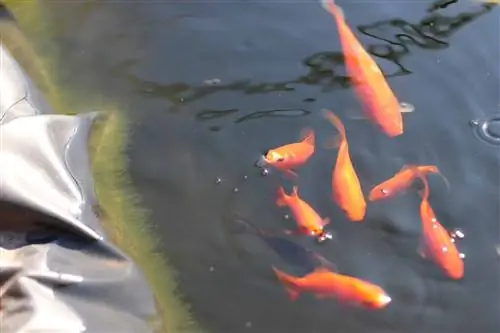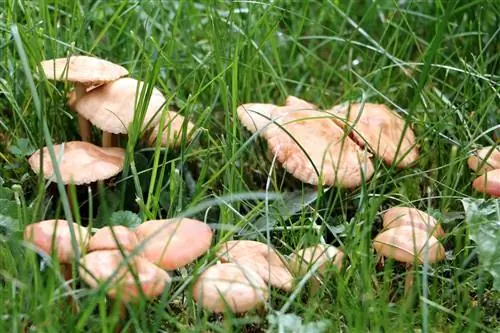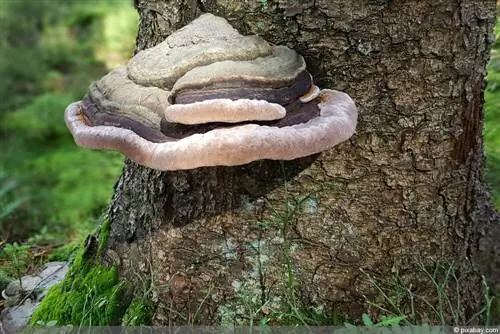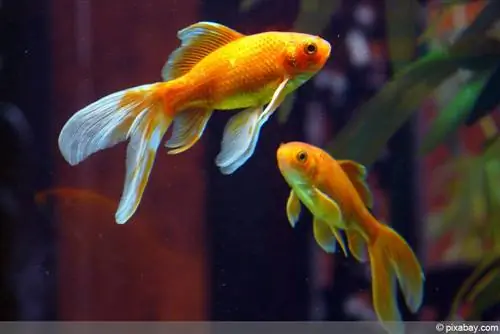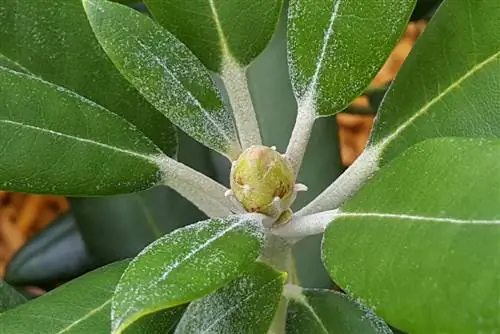- Author admin [email protected].
- Public 2023-12-17 03:39.
- Last modified 2025-01-24 12:45.
It is all the more worrying if one or more of the animals suddenly fall ill.
Causes of diseases
The outbreak of a goldfish disease can have many reasons, often several causes come together until a disease infestation ultimately occurs. The most important reasons are:
- Stress due to busyness
- Overfeeding or unsuitable food
- Infestation by bacteria, viruses, worms or fungi
- incorrect planting of the pond
If explained in more detail, this means that goldfish need space and peace in their biotope. Too many fish in a pond that is too small leads to fights and injuries. The fish should also experience as little stress as possible from humans. Too frequent handling within the pond mainly causes damage.
Goldfish are very frugal when it comes to feeding. If there is no fish food to hand, oatmeal or breadcrumbs will suffice for a while. You only need to be careful with too much food or a cheap brand of food!
Parasites live in every pond and are unavoidable. Nevertheless, the number can be reduced through careful water monitoring. Good water quality is the basis for a he althy fish population, as parasite infestation is one of the most common causes of disease.
The flora of the pond is at least as important as the inhabitants in the water. Aquatic plants provide goldfish with nutrients that cannot otherwise be supplied to them either naturally or artificially. Too many plants, on the other hand, create an excess of oxygen and in turn promote the bacterial balance. A he althy balance must be found here.
Changing the water temperature too quickly can also make the fish more susceptible to disease. This phenomenon can often be observed, especially in spring. Due to the rising temperatures, the protozoa and bacteria are multiplying, against which the phagocytes in the fish's mucous layer have no chance because they work in economy mode due to the hibernation. The immune system is still weak and the goldfish become infected more quickly.
The most important diseases
The clinical pictures of goldfish are just as diverse as the causes. The most common ones include:
- Semolina disease
- fin rot
- Staggering disease
- Gill Rot
- leech infestation
- Dropsy
Semolina disease is easy to diagnose. The affected fish is covered by small, white dots. The cause of this fungal infection is the ciliate, a pathogen that destroys the gills. This causes itching, which causes the fish to rub against solid objects and noticeably lose weight. If the parasite breaks away from the goldfish and falls to the bottom of the pond, it multiplies rapidly and infects other fish.
Fin rot is also transmitted by a pathogen, Saprolegnia. Another possible cause is an excessively large fish population or contaminated water. The clinical picture is manifested by inflammation of the tail fin, which gradually falls off. In most cases only a small stub remains.
Wodding disease is one of the most dangerous fish diseases in your own pond. In most cases it is caused by cheap fish food. The fungi it contains form bacteria in the fish intestine that occupy the entire body. This disease is highly contagious, especially through fish feces.
A particularly stubborn fungal infection on the gills is called gill rot. The reason for this is often a fish population that is too large coupled with a water temperature that has risen too much. The mushrooms are easy to recognize by their yellow-brown color. Affected goldfish also gasp for air noticeably frequently.
The fish leech can nest particularly well in muddy ponds that are overgrown with weeds. There it then attacks the goldfish by sucking itself onto them and leaving deep puncture wounds. The affected fish tend to behave conspicuously.
Ascites is caused by a viral infection and is manifested by an extremely bloated fish belly and bulging eyes. It is often caused by excessive temperature and oxygen fluctuations. You can counteract this with vitamin feeding and reducing the population.
What to do if the goldfish get sick?
Treatment options and measures vary from disease to disease. In principle, with most fish diseases it is advisable to prevent infection and isolate sick fish in quarantine. In many cases of illness, a copper-free broad-spectrum drug can be used. This has no side effects and inhibits inflammation. Malachite green chloride or malachite green oxalate with formalin helps with fungal and bacterial infestation. Antiseptic agents are beneficial when disinfecting skin injuries. If a parasite has worked its way deep into the body, formalin can provide relief.
However, in some cases, such as staggering disease and semolina disease, only the complete destruction of the fish population can help. The water must then be completely pumped out and the pond basin disinfected.
Preventing diseases
The worst diseases can be successfully prevented with regular water tests. The following values are important:
- pH value
- Temperature
- Nitrate content
- Water hardness
- Oxygen content
- Pollution level
The oxygen filter in the pond must also be checked regularly and maintained if necessary. It is advisable to regularly check the fish feces for tapeworms and their eggs so that any possible infection is nipped in the bud. The fish population should be kept constant to avoid overpopulation and space problems.
What you should know about goldfish in brief
Goldfish are easy to keep in a garden pond. With light supplementary feeding and monitoring of the water parameters and the animals' well-being, many illnesses should be prevented in advance. If this does happen, a quick diagnosis is necessary in order to initiate the appropriate medication or a necessary measure.
- The goldfish is a carp fish and can grow up to 35 cm long.
- The special breeding forms are usually a little smaller.
- As with all fish, the goldfish uses its swim bladder as a buoyancy organ.
- The fish usually eats its food at the bottom and chops it up with its pharyngeal teeth.
- A goldfish can see colors and has very good hearing.
The goldfish makes few demands on its environment and this not only makes it extremely easy to care for, but also justifies the fact that the goldfish is an important laboratory animal. Psychophysical experiments are carried out with him. You can get the goldfish in different breeding forms, for example in gold, silver, red, black, white, orange and also in yellow and blue. Well-known forms of goldfish include the veiltail, the telescope fish and the bubble eye.
The fish themselves and also the food can be found in any pet store. There are flake food, granulated food or food mixtures specifically tailored to the fish species that contain everything the fish need. It's best to ask at your pet store or find out more online.
The goldfish can spend the winter in the pond (see overwintering the goldfish), as long as it is deep enough and you ensure that it does not freeze. There are, for example, special Styrofoam devices that can be placed on the water. If you cannot prevent the harsh, icy winter, you should keep the fish in the aquarium at room temperature, which is not necessarily recommended simply because of the size of the animals. A sufficiently large garden pond would definitely be better.

